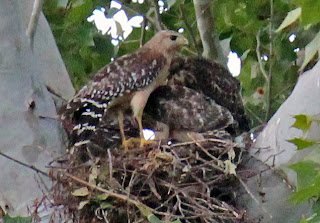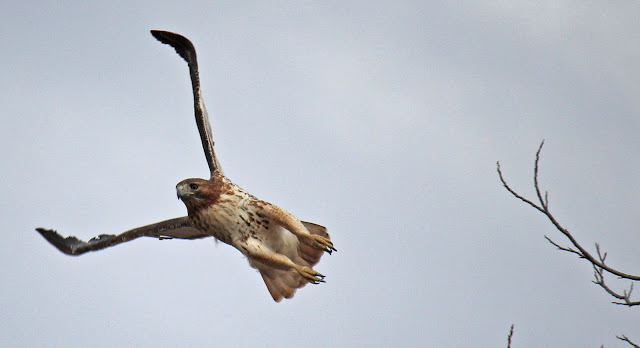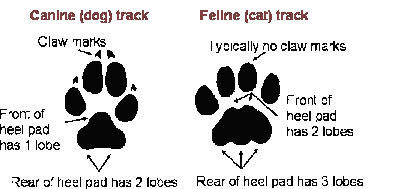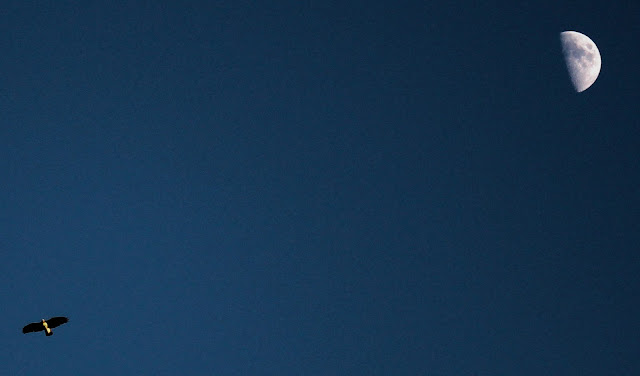Texas Winter — Predators of the Dallas Woods
Cold and austere, the post Christmas early morning light cast shadows on frozen ground so stiff it resembled old concrete. The previous evening’s snow has muffled the urban noise of the city that has grown up around these bottoms. The primate populous of that same city that calls it home has retreated indoors to loaf, channeling a deep seed of cave man DNA not to venture into the cold. During these special times, the rarely seen predators of the woods come forth from their shadows.
There is no better time to see the large carnivorous animals of Texas than after a bone chilling freeze. It seems that the cold drives these animals to hunt and explore more than any other season. Following are some photos taken during that North Texas cold snap between Christmas and New Years. Some are common sights while others are exceptionally rare.
 |
| Red Shouldered Hawk taking flight from a pecan in the Renda meadow below Scyene Overlook |
A certain fidelity exists among the animals here rarely seen by humans. Where we see simplicity, the reality is complexity. We might see it happen on a small scale out a kitchen window in the morning. Or in a carefully scripted fifty minute wildlife documentary on television. The real world life and death drama played out through window panes or a piece of LCD glass is no match for bearing witness in person.
 |
| The frozen climb up the north face of Scyene Overlook |
 |
| Coyote in Gateway Park |
The twenty degree overnight temperatures froze the ground solid here the night before. Locking rocks in place where they lay, turning the small scree slopes of the escarpment on which the trail lies into an easy to walk path.
In the far distance, a shy coyote makes a bolt across a fallow field for nearby Oak Creek. Coyotes are seldom seen, often heard and leave their scat everywhere. Weary hunters, they seem opportunistic in their forays around people. Fuller bodied than the swamp coyotes a few miles to the south, this Gateway Park yote seems to make meals out of more than just the local fauna. Pet food or garbage left outside are likely culprits. It beat a hasty retreat towards the DART Green Line where it crossed under the tracks using a small culvert for an unnamed creek.
 |
| JJ Beeman Trail in the Great Trinity Forest |
Red Shouldered Hawk hunting in the Renda Meadow
 |
| Red Shouldered Hawk beginning a hunting dive off a power pole in the Renda meadow |
A sharp, descending “kerr-yeee” scream announces the presence of the Red-shouldered Hawk as one enters the meadow near Scyene Overlook. Getting to the meadow is a worthwhile hike and sits mere minutes from Downtown Dallas.
Red Shouldered Hawks (Buteo lineatus) seem to be the most efficient raptors in the Great Trinity Forest. Medium in size and quite agile they can thread themselves through floodplain woods and bramble thickets with ease.
 |
| Renda meadow raptor |
Their diet consists of insects, lizards, snakes and smaller rodents. They will take down another bird from time to time but the bulk of their diet seems to be smaller ground dwelling animals. The Red Shouldered Hawk seen above was hunting field mice in the snow covered meadow. It appeared as though it was watching for movement under the snow then launching a dive to the target.
This past spring I was fortunate enough to see a pair of Red Shouldered Hawks build a nest on White Rock Creek. Checking in once every few weeks I could watch from some distance the different phases of hawk rearing from nest construction to the eventual hatching of hawklets. This particular nest hatched three and raised three to adulthood. I still here them from time to time calling to each other nearly a year later.
Hawks Over Piedmont Ridge
The gusting northwest winds blow strong updraft currents along the White Rock Escarpment. The abrupt hundred foot elevation differential creates an enticing loitering area for some of the largest winged predators in Dallas, the Red Tailed Hawk. Seen at left and below, the hawks pictured were riding the draft up in effortless concentric maneuver. Much like a spiral staircase, each rotation would take them an building story higher in the air.
Some of these hawks migrate in seasonally for the winter from the northern plains, others stay year round. I imagine the hawks view this ridge of Trinity chert gravel topped limestone as an island of sorts. A place to survey many acres of prime hunting fields.
 |
| Snow covered Piedmont Ridge Overlook |
 The large population of hawks in this area might be the result of the easy to hunt areas on the Grover Keeton Golf Course. The large number of nut bearing pecans here attract squirrels and the cropped grass keeps a stable population of rabbits.
The large population of hawks in this area might be the result of the easy to hunt areas on the Grover Keeton Golf Course. The large number of nut bearing pecans here attract squirrels and the cropped grass keeps a stable population of rabbits.
Hawks are too small to predate the largest four legged menace in these woods, the feral pig. Signaled with the installation of traps and a feeder within 50 yards of the Gateway Trail, feral pigs have made the move to Scyene. The DART Green Line fencing serves as an effective barricade against pig migration to some extent. From the looks of the recent tracks near the DART crossing at Glover Pass, some of the pigs are quite large. One can only hope that the widespread extermination of non-target species (deer, bobcats, coyotes and birds) as evidenced near the Audubon Center will not accompany the attempts to eradicate the feral pigs from the Scyene Overlook area.
 |
| Snow covered juniper stump along the Piedmont Ridge Trail |
Devon Anderson Trail
 |
| Devon Anderson Trail south of Bruton Road |
 |
| Red Tailed Hawk being harassed by a Mockingbird |
Belonging more to the air than to the tree limbs on which it sits perched, hawks are often the subject of harassment by lesser birds. Like a monkey on his back, the mockingbird makes insulting remarks and curse statements at a bird fifty times in size. Annoyed, the hawk reluctantly takes flight moving to another tree nearby.
 |
| Footbridge over the dry gulch in Devon Anderson Park |
The Great Horned Owls — Master Hunters of the night
The fabric of Texas Lore is wound tight with the Great Horned Owl (Bubo virginianus). Modern day Texans are poorer for never having heard one. The booming voice of evening calls to attract a mate resonate louder than a man can yell.
The Native Americans saw the Great Horned Owl as a harbinger of death and bad luck. An owl near their camps while revered by their beliefs was a forboding sign.
The Spanish Conquistadors and missionaries that first colonized Tejas in the 17th Century blended the ancient Caddo stories of owls into their own. Es como los tecalotes; la viveza lo tiene en los ojos. He is like the owls; all his liveliness of wit is in his eyes.
Mexican bandits often thought the Great Horned Owl’s call was “Refugio, Refugio, Refugio”. Refuge. Refuge. Refuge. Hiding for a night under a tree used by an owl was a sure sign of a remote sanctuary.
The old Texas pioneer rhyme that dates back to the mid 19th century has similar parallels to them all :A wise old owl lived in an oak, The more he saw the less he spoke,The less he spoke the more he heard. Why can’t we all be like that wise old bird?
“Uncommon but widespread” is how many field guides list many winged predators. This applies to the Great Horned Owls especially. Owls are apex night hunters and the preferred technique for Great Horned Owls is to perch on a pole or cliff or other site with a view, watching and listening for prey. Spotting or hearing potential dinner, they launch off and dive in on silent wings to snatch the unlucky critter in incredibly strong and large talons. With two foot long bodies, five foot wingspans and talons with crushing power over 300 psi, Great Horned Owls are one of the few birds that can kill animals larger than themselves.
Hearing a great predator call in the moon lit air of sunset is a rare occasion inside the city limits of Dallas. Seeing one is quite unique given their nocturnal schedules. Getting some photographs of one is even harder to come by. For the intrepid willing to brave the cold, the chance to get some owl photos was a rare chance indeed. Below is some footage I shot of one Great Horned Owl. It was a cloudy and foggy evening after sunset.
Seeing the owl in the fork of a tree, I placed a camera and tripod some hundreds of feet away. Then left the area. Over the course of the next twenty minutes it made territorial calls a number of times, calling for a distant mate. Around the 1:50 mark or so the distant return calls of the second owl can be heard in the far background. Towards the end of the clip, the owl leaves to join the other. I have not seen many Great Horned Owl videos on the internet. Nearly all seem to be of owls in captivity. Quite entertaining to hear the owl hooting 500+ yards away knowing down in the woods your camera is catching it all.
Much of the groundwork for knowing about this particular pair of Great Horned Owls was done by Robert Bunch, a professional photographer of note based in the Dallas area. His willingness to share his find and donate personal time for chronicling birds in Dallas is exceptional. His website features some of his great wildlife photos Robert Bunch Photography. I had heard owls many times previous to this in the Great Trinity Forest and caught fleeting glimpses of them but never seen one so close. Joining Robert was another great photographer Geryl Mortensen of Birds Afield. He made waves last winter with his Texas Snowy Owl photos that caused quite a bit of buzz. Both those guys are outstanding photographers and seem like exceptional people to boot. A pleasure meeting them both. I’m a two bit idiot with a camera compared to what they bring. Really nice to meet ethical folks with an appreciation for keeping an unobtrusive distance to wildlife.
Urban Bobcats – The Bobcats Of White Rock Lake
 |
| Bobcat at White Rock Lake December 30, 2012 |
The bobcat (lynx rufus) is the most common wildcat in the United States. Their name comes from their short bobbed tail and is easy to spot from some distance. Varying in color and size, they can take on a gray milk color or a more exotic leopard pattern like the one seen in the photos here. With the magnified toolset of a house cat many times over, the bobcat is an apex predator across the North Texas landscape. Only an unfortunate run-in with a bullet or a car bumper stand in the way of their demise as adults.
 |
| Bobcat at Sunset Bay, White Rock Lake, Dallas, Texas near the CCC Statue |
Roughly the size of a medium dog, this particular bobcat was seen at White Rock Lake about an hour before a cold cloudy sunset on the last weekend of 2012. Blending in well with the dormant grass it moved virtually unnoticed across a couple acres of open ground at Sunset Bay near walkers, runners and cyclists.
 |
| White Rock Lake bobcat marking scent on brush next to the Sunset Bay offices |
 Like many cats, this bobcat appeared to be on a daily patrol, marking territory with facial scrapes and urinating on brush. There is more than one bobcat in this immediate area and claiming territory of your own is an important job duty for any cat. Looking at the facial features and overall girth, this bobcat is most likely a younger individual maybe the result of litter last spring.
Like many cats, this bobcat appeared to be on a daily patrol, marking territory with facial scrapes and urinating on brush. There is more than one bobcat in this immediate area and claiming territory of your own is an important job duty for any cat. Looking at the facial features and overall girth, this bobcat is most likely a younger individual maybe the result of litter last spring.
The bobcat like others I have seen at the lake have found a way to coexist with people in a non-threatening manner. Their prey diet consists of rodents, waterfowl and small game that live around White Rock Lake. Seeing a cat this size along the hedges here would give a dog owner a reflective pause before letting a pet run off leash. No need to worry. The cats seem to have a healthy respect for humans and their canine companions. They keep their distance and so should you.
Comparing a bobcat to a mountain lion ……..
Poor light, long distances and excitement can often confuse your eyes into seeing something that is not there. The illustration above shows the main differences between the larger mountain lion and the bobcat. 3 feet long for a bobcat, 7-8 feet long for a mountain lion. Similar coat colors, similar markings.
 |
| Comparing cougar, coyote and bobcat tracks, Courtesy TPWD |
Despite claims of mountain lions in the Dallas area, the tales of big cats are just that. Concoctions of rumors, third hand accounts and a healthy dose of misinformation. Even the prints of large dogs are misidentified as mountain lions all the time. The prints above illustrate the similarities and marked differences between the animals. It’s unclear how someone could not tell the difference but it happens all the time.
It’s a paradox to often find images such as these in the most violent and impoverished neighborhoods of Texas. Places that many reading this will never visit for fear of the people who call it home. I wonder what it will take to change that.














